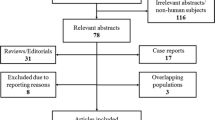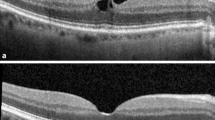Abstract
Purpose
To evaluate the efficacy of intravitreal ocriplasmin for the resolution of vitreomacular traction (VMT) with or without a full thickness macular hole (FTMH) in the clinical setting and to assess whether the indication spectrum of this treatment modality can be expanded beyond that of the MIVI-TRUST trials.
Methods
The records of patients with VMT with or without FTMH, who were treated with intravitreal ocriplasmin were reviewed. Patients were divided in two groups. In the first group, VMT with or without FTMH was present without any other macular pathology. In the second group, VMT with or without FTMH occurred alongside of other macular disease including age-related macular degeneration, diabetic maculopathy and post-operative pseudophakic cystoid macular edema.
Results
Release of the VMT was achieved in 12/20 patients (12/20 eyes) of the first group. 16 eyes in this group met 3 or more criteria known to be associated with favorable prognosis after intravitreal ocriplasmin treatment. No cases of release of the VMT were observed in the second group, which included 15 patients (15 eyes). Significant improvement of visual acuity and reduction of the central macular thickness was observed only in the subgroup of eyes which responded to treatment.
Conclusions
Concomitant macular pathology was a significant factor for treatment failure and we suggest that ocriplasmin should be regarded with caution in these cases. Careful patient selection for treatment with ocriplasmin using specific criteria in the clinical setting can provide superior results to those reported in the MIVI-TRUST trials.



Similar content being viewed by others
References
Duker JS, Kaiser PK, Binder S, de Smet MD, Gaudric A, Reichel E et al (2013) The international Vitreomacular traction study group classification of vitreomacular adhesion, traction, and macular hole. Ophthalmology 120:2611–2619
Stalmans P, Benz MS, Gandorfer A, Kampik A, Girach A, Pakola S et al (2012) MIVI-TRUST study group. Enzymatic vitreolysis with ocriplasmin for vitreomacular traction and macular holes. N Engl J Med 367:606–615
Jackson TL, Nicod E, Simpson A, Angelis A, Grimaccia F, Kanavos P (2013) Symptomatic vitreomacular adhesion. Retina 33:1503–1511
Bertelmann T, Kičová N, Messerschmidt-Roth A, Irle S, Sekundo W, Mennel S (2011) The vitreomacular interface in retinal vein occlusion. Acta Ophthalmol 89:e327–e331
Schulze S, Hoerle S, Mennel S, Kroll P (2008) Vitreomacular traction and exudative age-related macular degeneration. Acta Ophthalmol 86:470–481
Mennel S, Meyer CH, Schmidt JC (2011) Der Einfluss des Glaskörpers auf die Pathogenese der altersabhängigen Makuladegeneration. Klin Monatsbl Augenheilkd 228:460–464
Krishnan R, Arora R, De Salvo G, Stinghe A, Severn PS, Pal B et al (2015) Vitreomacular traction affects anti-vascular endothelial growth factor treatment outcomes for exudative age- related macular degeneration. Retina 35:1750–1756
Houston SK III, Rayess N, Cohen MN, Ho AC, Regillo CD (2015) Influence of vitreomacular interface on anti- vascular endothelial growth factor therapy using treat and extend treatment protocol for age-related macular degeneration (VINTREX). Retina 35:1757–1764
Meyer CH, Toth CA (2001) Retinal pigment epithelial tear with vitreomacular attachment: a novel pathogenic feature. Graefes Arch Clin Exp Ophthalmol 239:325–333
Laidlaw DA (2008) Vitrectomy for diabetic macular oedema. Eye (Lond) 22:1337–1341
Haller JA, Qin H, Apte RS, Beck RR, Bressler NM, Browning DJ et al (2010) Diabetic retinopathy clinical research network writing committee. Vitrectomy outcomes in eyes with diabetic macular edema and vitreomacular traction. Ophthalmology 117:1087–1093
Barzt-Schmidt KU, Bertram N, Bornfeld N, Bresgen M, Eter N, Feltgen N et al (2013) Aktuelle Stellungnahme der Deutschen Ophthalmologischen Gesellschaft, der Retinologischen Gesellschaft und des Berufsverbandes der Augenärzte Deutschlands zur therapeutischen intravitrealen Anwendung von Ocriplasmin (JETREA) in der Augenheilkunde. Klin Monatsbl Augenheilkd 230:629–634
Theodossiadis GP, Grigoropoulos VG, Theodoropoulou S, Datseris I, Theodossiadis PG (2014) Spontaneous resolution of vitreomacular traction demonstrated by spectral-domain optical coherence tomography. Am J Ophthalmol 157:842–851
Singh RP, Li A, Bedi R, Srivastava S, Sears JE, Ehlers JP et al (2014) Anatomical and visual outcomes following ocriplasmin treatment for symptomatic vitreomacular traction syndrome. Br J Ophthalmol 98:356–360
Sharma P, Juhn A, Houston SK, Fineman M, Chiang A, Ho A, Regillo C (2015) Efficacy of intravitreal ocriplasmin on vitreomacular traction and full thickness macular holes. Am J Ophthalmol 159:861–867
Lommatzsch AP, Gutfleisch M, Dietzel M, Heimes B, Spital G, Böhme M et al (2014) Erste klinische Erfahrungen bei der Behandlung von vitreomakulären Traktionen mit Ocriplasmin. Klin Monatsbl Augenheilkd 231:909–914
Chatziralli I, Theodossiadis G, Parikakis E, Datseris I, Theodossiadis P (2016) Real life experience after intravitreal ocriplasmin for vitreomacular traction and macular hole: a spectral-domain optical coherence tomography prospective study. Graefes Arch Clin Exp Ophthalmol 254:223–233
Kim BT, Schwartz SG, Smiddy WE, Doshi RR, Kovach JL, Berrocal AM et al (2013) Initial outcomes following intravitreal ocriplasmin for treatment of symptomatic vitreomacular adhesion. Ophthalmic Surg Lasers Imaging Retina 44(4):334–343
Feng HL, Roth DB, Hasan A, Fine HF, Wheatley M, Prenner JL et al (2017) Intravitreal ocriplasmin in clinical practice. Predictors of success, visual outcomes, and complications. Retina. doi:10.1097/IAE.0000000000001505
Steel DHW, Parkes C, Papastavrou VT, Avery PJ, El-Ghrably IA, Habib MS et al (2016) Predicting macular hole closure with ocriplasmin based on spectral domain optical coherence tomography. Eye 30:740–745
Hager A, Seibel I, Riechardt A, Rehak M, Joussen AM (2015) Does ocriplasmin affect the RPE-photoreceptor adhesion in macular holes? Br J Ophthalmol 99:635–638
Reiss B, Smithen L, Mansour S (2015) Transient vision loss after ocriplasmin injection. Retina 35:1107–1110
Paul C, Heun C, Müller HH, Fauser S, Kaymak H, Kazerounian S et al (2016) Impact of vitreoretinal interface architecture on successful vitreomacular traction resolution in eyes scheduled for intravitreal ocriplasmin therapy. Retina. 2016 Oct 26. [Epub ahead of print]
Krebs I, Brannath W, Glittenberg C, Zeiler F, Sebag J, Binder S (2007) Posterior vitreomacular adhesion: a potential risk factor for exudative age-related macular degeneration? Am J Ophthalmol 144:741–746
Stefansson E (2001) The therapeutic effects of retinal laser treatment and vitrectomy. A theory based on oxygen and vascular physiology. Acta Ophthalmol Scand 79:435–440
Reese AB, Jones IS, Cooper WC (1967) Macular changes secondary to vitreous traction. Am J Ophthalmol 64:544–549
Ciulla TA, Ying GS, Maguire MG, Martin DF, Jaffe GJ, Grunwald JE et al (2015) Comparison of age-related macular degeneration treatments trials research group. Influence of the Vitreomacular Interface on treatment outcomes in the comparison of age-related macular degeneration treatments trials. Ophthalmology 122:1203–1211
Lee KH, Chin HS, Kim NR, Moon YS (2015) Effects of Vitreomacular traction on Ranibizumab treatment response in eyes with Neovascular age-related macular degeneration. Korean J Ophthalmol 29:396–403
Meyer CH, Mennel S, Schmidt JC (2006) Occult vitreo-macular traction may cause traumatic RPE tears. Acta Ophthalmol Scand 84:560
Schmidt JC, Mennel S, Hoerle S, Meyer CH (2006) High incidence of vitreomacular traction in recurrent choroidal neovascularization after repeated photodynamic therapy. Br J Ophthalmol 90:1361–1362
Quiram PA, Leverenz VR, Baker RM, Dang L, Giblin FJ, Trese MT (2007) Microplasmin-induced posterior vitreous detachment affects vitreous oxygen levels. Retina 27:1090–1096
Stefansson E (2008) Microplasmin-induced posterior vitreous detachment affects vitreous oxygen levels. Retina 28:1175–1176
Shah SP, Patel M, Thomas D, Aldington S, Laidlaw DA (2006) Factors predicting outcome of vitrectomy for diabetic macular oedema: results of a prospective study. Br J Ophthalmol 90:33–36
Harbour JW, Smiddy WE, Rubsamen PE, Murray TG, Davis JL, Flynn HW Jr (1995) Pars plana vitrectomy for chronic pseudophakic cystoid macular edema. Am J Ophthalmol 120:302–307
Bertelmann T, Witteborn M, Mennel S (2012) Das pseudophakiebedingte zystoide Makulaödem. Klin Monatsbl Augenheilkd 229:798–781
Novack RL, Staurenghi G, Girach A, Narendran N, Tolentino M (2015) Safety of intravitreal ocriplasmin for focal vitreomacular adhesion in patients with exudative age-related macular degeneration. Ophthalmology 122:796–802
Wheatley HM (2008) Posterior vitreomacular adhesion and exudative age-related macular degeneration. Am J Ophthalmol 145:765
Matsunaga N, Ozeki H, Hirabayashi Y, Shimada S, Ogura Y (2005) Histopathologic evaluation of the internal limiting membrane surgically excised from eyes with diabetic maculopathy. Retina 25:311–316
Gandorfer A, Rohleder M, Grosselfinger S, Haritoglou C, Ulbig M, Kampik A (2005) Epiretinal pathology of diffuse diabetic macular edema associated with vitreomacular traction. Am J Ophthalmol 139:638–652
Tah V, Keane PA, Esposti SD, Allimuthu J, Chen FK, Da Cruz L et al (2014) Repeatability of retinal thickness and volume metrics in neovascular age-related macular degeneration using the Topcon 3DOCT-1000. Indian J Ophthalmol 62:941–948
Parravano M, Oddone F, Boccassini B, Menchini F, Chiaravalloti A, Schiavone M, Varano M (2010) Reproducibility of macular thickness measurements using cirrus SD-OCT in neovascular age-related macular degeneration. Invest Ophthalmol Vis Sci 51:4788–4791
Kaiser PK, Kampik A, Kuppermann BD, Girach A, Rizzo S, Sergott RC (2015) Safety profile of ocriplasmin for the pharmacologic treatment of symptomatic vitreomacular adhesion/traction. Retina 35:1111–1127
Chan CK, Crosson JN, Mein CE, Daher N (2017) Pneumatic vitreolysis for relief of vitreomacular traction. Retina. doi:10.1097/IAE.0000000000001448
Steinle NC, Dhoot DS, Quezada Ruiz C, Castellarin AA, Pieramici DJ, See RF et al (2017) Treatment of vitreomacular traction with intravitreal perfluoropropane (C3F8) injection. Retina 37:643–650
Author information
Authors and Affiliations
Corresponding author
Ethics declarations
Funding
No funding was received for this research.
Conflict of interest
All authors certify that they have no affiliations with or involvement in any organization or entity with any financial interest (such as honoraria; educational grants; participation in speakers’ bureaus; membership, employment, consultancies, stock ownership, or other equity interest; and expert testimony or patent-licensing arrangements), or non-financial interest (such as personal or professional relationships, affiliations, knowledge or beliefs) in the subject matter or materials discussed in this manuscript.
Ethical approval
All procedures performed in studies involving human participants were in accordance with the ethical standards of the institutional and/or national research committee and with the 1964 Helsinki Declaration and its later amendments or comparable ethical standards.
Informed consent
For this retrospective study, formal consent is not required.
Rights and permissions
About this article
Cite this article
Manousaridis, K., Peter-Reichart, S. & Mennel, S. Ocriplasmin treatment for vitreomacular traction in real life: can the indication spectrum be expanded?. Graefes Arch Clin Exp Ophthalmol 255, 1907–1916 (2017). https://doi.org/10.1007/s00417-017-3731-9
Received:
Revised:
Accepted:
Published:
Issue Date:
DOI: https://doi.org/10.1007/s00417-017-3731-9




